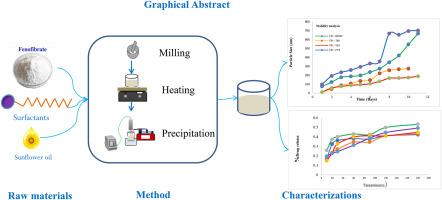Fenofibrate nano-suspension formulation using hot melt emulsion followed by precipitation
IF 4.9
3区 医学
Q1 PHARMACOLOGY & PHARMACY
Journal of Drug Delivery Science and Technology
Pub Date : 2025-09-26
DOI:10.1016/j.jddst.2025.107576
引用次数: 0
Abstract
Fenofibrate is a pharmaceutical drug of the fibrate class, which is used to lower abnormal lipid levels in the blood. However, fenofibrate suffers from poor bioavailability due to its hydrophobic nature and negligible water solubility. The generation of nanosuspension with increased surface area is one of the mechanisms to minimize this challenge. In this work, fenofibrate nanosuspension was formulated to improve the solubility of the drug. A method of hot melt emulsification followed by precipitating the hot melt into a cold aqueous medium was employed to generate the nanosuspension. Ultrasound energy and stabilizers such as Hydroxymethyl cellulose (HPMC), Polyvinyl Pyrrolidone (PVP), and Bovine Serum Albumin (BSA), along with surfactants including Tween 80 (T80) and Sodium Lauryl Sulphate (SLS), were used to control particle growth and improve the stability of the resulting suspension. Sunflower oil was used as a co-additive agent. The effects of surfactants, ultrasound energy and sonication time, drug to surfactant ratio, and sunflower oil on particle size and suspension stability were investigated. The use of ultrasound sonication during both the hot-melt formation step and the precipitation step produced smaller particle sizes. A ground mixture of fenofibrate with BSA and SLS, in the presence of 3 mL sunflower oil, produced a nanosuspension with particle sizes below 100 nm, exhibiting a relatively lower particle growth rate and improved stability. Using a lower molecular weight BSA surfactant and incorporating sunflower oil produced substantial improvement in the particle size reduction and enhancement of the suspension's stability.

非诺贝特纳米悬浮液的配方采用热熔乳液后沉淀
非诺贝特是一种贝特类药物,用于降低血液中的异常脂质水平。然而,非诺贝特由于其疏水性和可忽略的水溶性,其生物利用度较差。随着表面积的增加,纳米悬浮液的产生是减少这一挑战的机制之一。在这项工作中,配制非诺贝特纳米混悬液以提高药物的溶解度。采用热熔胶乳化,然后将热熔胶沉淀到冷的水介质中,以产生纳米悬浮液。超声能量和稳定剂如羟甲基纤维素(HPMC)、聚乙烯吡咯烷酮(PVP)和牛血清白蛋白(BSA),以及表面活性剂包括T80 (T80)和月牙酰基硫酸钠(SLS),用于控制颗粒生长和提高所得到的悬浮液的稳定性。以葵花籽油为共添加剂。考察了表面活性剂、超声能量和超声时间、药物与表面活性剂比、葵花籽油对悬浮粒径和悬浮稳定性的影响。在热熔形成步骤和沉淀步骤中使用超声波产生较小的颗粒尺寸。非诺贝特与BSA和SLS的研磨混合物,在3ml葵花籽油的存在下,产生粒径小于100 nm的纳米悬浮液,表现出相对较低的颗粒生长速度和更高的稳定性。使用较低分子量的BSA表面活性剂并加入葵花籽油,在降低颗粒尺寸和增强悬浮液稳定性方面取得了显著改善。
本文章由计算机程序翻译,如有差异,请以英文原文为准。
求助全文
约1分钟内获得全文
求助全文
来源期刊
CiteScore
8.00
自引率
8.00%
发文量
879
审稿时长
94 days
期刊介绍:
The Journal of Drug Delivery Science and Technology is an international journal devoted to drug delivery and pharmaceutical technology. The journal covers all innovative aspects of all pharmaceutical dosage forms and the most advanced research on controlled release, bioavailability and drug absorption, nanomedicines, gene delivery, tissue engineering, etc. Hot topics, related to manufacturing processes and quality control, are also welcomed.

 求助内容:
求助内容: 应助结果提醒方式:
应助结果提醒方式:


